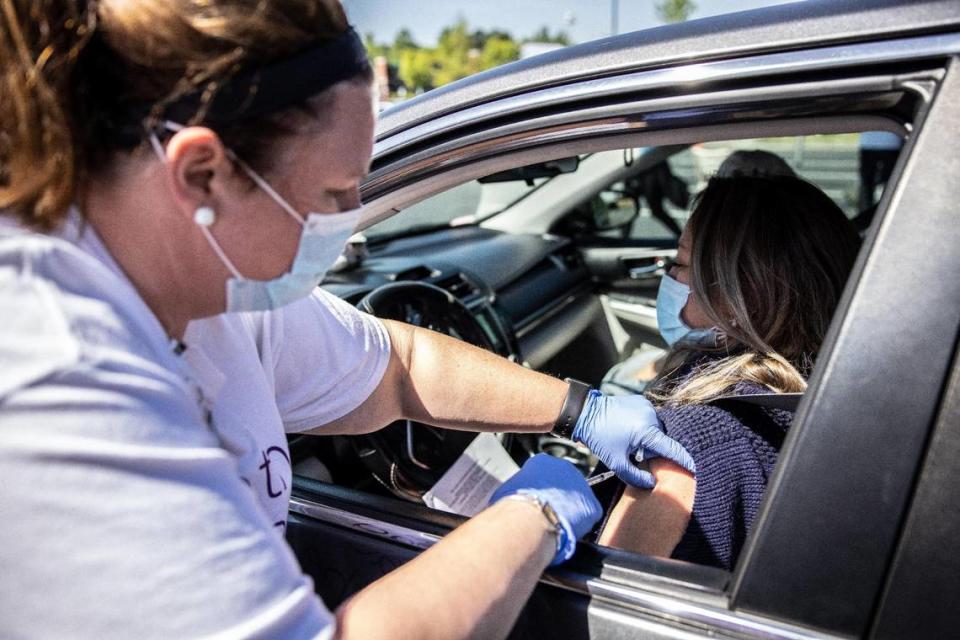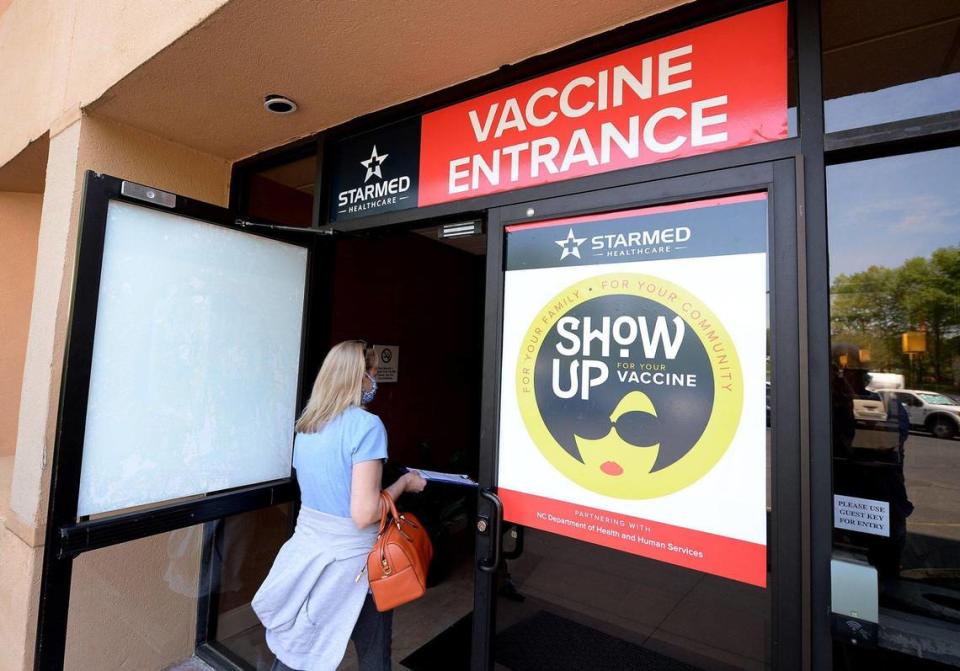A neighborhood-by-neighborhood look at COVID vaccination rates shows large disparities
Listen to our daily briefing:
Subscribe: Apple Podcasts | Spotify | Amazon Alexa | Google Assistant | More options
New data on COVID-19 vaccination rates across Mecklenburg County neighborhoods highlight a persistent disparity between wealthy and poor communities, as wide as nearly 70 percentage points in one instance, an Observer analysis found.
In some affluent neighborhoods in Mecklenburg, as many as 60% or more of residents are now vaccinated against COVID-19, new public health data obtained by the Observer show.
But in Mecklenburg’s crescent — a band of high-poverty neighborhoods in east, north and west Charlotte — the percentage is closer to 20%, or in some cases, much lower. The gap in vaccination rates echoes the same disparities that led to elevated coronavirus infection rates across Black and brown communities.
The Observer analyzed state data showing the rates of residents ages 16 and older fully vaccinated against the coronavirus across Mecklenburg County by census tracts, areas smaller than ZIP codes that provide neighborhood-level details.
It’s the same type of information local health officials had requested, but not obtained, from the state for weeks. Mecklenburg health department officials had complained during recent meetings that they could not access the localized data, but the Observer was able to view the data from the state online.
The data also highlighted the racial disparity among the vaccination rates.
Predominantly white neighborhoods have higher vaccination rates, data show. About half the residents who live in neighborhoods that are at least 80% white are vaccinated. That compares to the 23% of residents who live in communities that are at least 80% Black who are vaccinated.
The more granular look at the inequity surrounding Mecklenburg’s COVID-19 vaccination efforts comes weeks after the county health department released ZIP code data for the first and only time. That information also underscored how vaccination rates in Mecklenburg’s most vulnerable areas lag far behind more affluent areas in the county.
County officials did not make health department leaders available for interviews regarding the census tract findings.
But earlier this month, Public Health did launch a partnership with advocacy group Action NC to address equity issues. The county ran a training workshop for 15 Action NC employees, including four bilingual workers, who are now going door-to-door, educating people about nearby vaccine clinics.

New Mecklenburg vaccine data
The census tract data runs through April 27. More than 272,800 people were fully vaccinated as of that date, the data show.
Some of the neighborhoods with the lowest vaccination rates are in west Charlotte — near Interstate 77 and Billy Graham Parkway — and in east Charlotte along Albemarle Road or Interstate 85, according to the Observer’s analysis.
Most neighborhoods along I-85 northeast of uptown have vaccination rates ranging from 6% to 20%, data show.
But along Providence Road in south Charlotte — where many of the city’s most affluent neighborhoods reside — rates top 52%.
Areas around Myers Park and Eastover, for instance, have a vaccination rate of 64%. The only area with a higher rate is parts of Dilworth along East Morehead Street, just south of uptown. Rates there top 74%.
“We do have to pour more resources into those communities that are most vulnerable and where we’re seeing the low vaccination rates,” said Chantel Martin, an assistant professor at the UNC Gillings School of Global Public Health in Chapel Hill, whose research focuses on health disparities. “We have to take more targeted approaches. You have to engage those communities and listen to the people.”
Martin cautioned against attributing yawning vaccination gaps to hesitancy in communities of color. That overlooks more systemic issues, she said, including barriers to accessing the vaccine from the earliest days of distribution.

‘Serious disconnect’
In interviews with the Observer, two Black elected officials expressed mounting frustration that people of color are being immunized at sharply lower rates than white residents.
“Frankly, we have to put a stop to it. We can’t continue to go down this road,” County Commissioner Mark Jerrell said. “There is a serious disconnect between our attempts (at equity) and our outcomes. I think our hearts are in the right place, but we’re not producing the outcomes we need, particularly in our vulnerable communities.”
The range in vaccination rates among people 16 years and older by census tract is wide — from the lowest rate of 5.6% to nearly 75%, state health data show.
In the 57 Mecklenburg County census tracts where Black people comprise half or more of the population, the highest vaccination rate is 38.7%. That’s in a community just east of uptown near North Davidson Street and Hawthorne Lane. Meanwhile, 69 predominantly white census tracts rank higher than that.
Leake envisions an equitable COVID-19 vaccine rollout where pop-up clinics are scattered across areas like Beatties Ford Road, LaSalle Street, Wilkinson Boulevard and West Boulevard.
“You go where the people are, and they have not done that,” County Commissioner Vilma Leake said of earlier health department efforts. “I’m spinning my wheels.”
And make clinics in the crescent appealing by tacking on more community resources on the spot, Jerrell says, like free health screenings and supermarket gift cards.
Overcoming the gap in vaccination rates may require an “over-correction in the way we are distributing and allocating the vaccine,” Jerrell said.
Going door-to-door
Martin, the UNC epidemiologist, said she’s become a trusted messenger to friends and family members looking for more information about the vaccines. It’s the candid, back-and-forth conversation that can make all the difference in a successful vaccination campaign, Martin said.
“Once people are hearing from folks within their networks (and) seeing people within their networks getting vaccinated, that will start to spread vaccinations,” Martin said. “These relationships are very important.”
Charlotte-area Action NC Political Director Robert Dawkins has been part of the county’s new door-to-door vaccination education effort. He said so far, Action NC workers have been concentrated in areas in the crescent of Charlotte, including east and north Charlotte neighborhoods.
The crescent is home to some of Charlotte’s lowest income areas. Neighborhoods with a median household income of $33,000 — half of the county’s average — have a vaccination rate of 16%, the Observer’s analysis found.
But in areas where the median household income is $100,000 or more, the vaccination rate tripled to 48%.
Action NC workers will be out “in full force” on Saturday, Dawkins said, going door-to-door in the neighborhood around a Mecklenburg County vaccine clinic at Movement School Eastland, at 5249 Central Ave. The Movement School Eastland falls into a census tract with a vaccination rate of 16% as of late April, according to the state data.
Dawkins said one of the biggest issues Action NC workers have seen recently is what Gov. Roy Cooper has called a “casual hesitancy” toward the vaccine.
Some people believe that if others in the Charlotte area get the vaccine, they don’t need to, Dawkins said. But that’s not true, health experts say.
With vaccination rates slowing, it’s looking more and more unlikely Mecklenburg County will reach the threshold for herd immunity, local experts say.
That’s one reason vaccine providers are trying to make it easier to get the vaccine, from accepting walk-ins, to setting up mobile vaccine clinics and sending people like Dawkins out to spread the word.
“We’re just hoping people will take advantage,” Dawkins said. “Because we all want to get back to normal, but waiting (to get the vaccine) is keeping us from getting there.”

